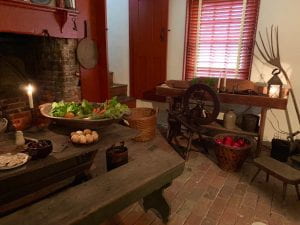While some students were taking a tour facilitated by one of the members of the Odessa Historic Foundation, others gathered at the IEC lab at the University of Delaware alongside professional archaeologists to continue washing and drying artifacts found with metal detectors as well as the ones found on the surface of the field.
Students that were discovering historic Odessa learned more about the time period we are hoping to identify at the Colemans Farm. Some  of them highlighted certain characteristics of the changes through time at the town and the importance of the Appoquinimink creek during the 1700-1800 time period.
of them highlighted certain characteristics of the changes through time at the town and the importance of the Appoquinimink creek during the 1700-1800 time period.
During colonial times Odessa was a grain shipping port called Cantwell’s Bridge. Now, houses from the 18th and 19th century remain almost intact at Odessa. Students also had the opportunity to visit the Corbit-Sharp house which is a good example of a Philadelphia-Georgian style. They visited the Wilson Warner House and walked inside smoke rooms or spaces that were used for smoking activity in the past. Furthermore, they visited the Collins-Sharp House and learned about different cooking recipes as well as earthenware ceramics from the 18th and 19th century. Finally, students walked twice through the main street and observed from the outside the bank as well as the Brick Hotel where most merchants and ship captains stayed through the busy days of the Cantwell’s Bridge.
Back at the IEC lab, students had another opportunity to look at the artifacts more closely and better identify their physical characteristics, the possible origins and time periods of objects found.
Most of the artifacts consisted on nails, brick and earthenware.
During the afternoon session at the lab, students discussed what were going to be the next steps for opening test units. Some suggested we should open both of the anomalies located by the GPR just to make sure we are not skipping any important data that might be relevant. Other students suggested opening STPs with features located at (N0, W125 and N0 W50) because they are located within the high nail/brick concentration areas and were already identified as potentially interesting.
It is interesting how the collection of blogs from people working on the field helps broaden the knowledge gathered by the experience of exploring an archeological site.
Michelle Ramirez
